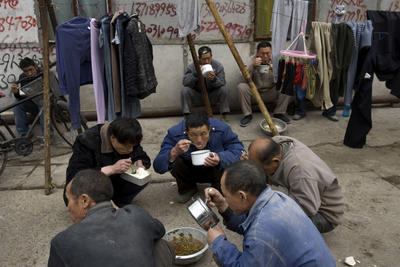The real daily wages of paid agricultural workers in the same period rose even faster — 15.1 per cent in grains, 21.4 per cent in larger pig farms, and 11.7 per cent in cotton.
Even during 2008 and 2009, when the Chinese economy was affected by the global financial crisis, the trend of growing wages did not stop. In 2010, the real wage of migrant workers increased by 19 per cent. Even this increase did not ameliorate the severe shortage of unskilled workers. The labour shortage and wage increases attracted minimal scholarly attention before the crisis, but are now a major concern to investors and managers.
Wage increases are likely to continue into the long term for two reasons: first, China’s working age population is about to stop growing very shortly, and, second, the government has committed to to reducing inequality. For example, the 12th Five-Year Plan targets an annual increase in the minimum wage level of no less than 13 per cent.
The constant upward trend in Chinese wages has also had some significant consequences for macroeconomic policy, industrial reallocation and income distribution.
On the macroeconomic front, the growth in the cost of labour has increased competitive pressure for small and medium-sized enterprises and produced structural and spatial reallocation among Chinese industries. A large proportion of enterprises have encountered operating difficulties, particularly in 2011. This is an expected and, to a certain extent, desirable development, because it is a manifestation of creative destruction, which helps to form a new industrial structure and establish a new growth pattern. But given such changes in the relative price of factors will inevitably lead enterprises to respond through technological choices and structural adjustment, the authorities need to remember that relatively consistent, stable macroeconomic policies will be necessary for innovation and investment innovation. Such activities can be fully financed only in a relatively loose macroeconomic policy environment. Macroeconomic policies aimed at cooling down the Chinese economy are perhaps too tight to support business adjustment.
With regard to industrial allocation, the inflation in Chinese wages has begun to affect wage changes in neighbouring countries, especially those that intend to pick up the labour-intensive industries being discarded by China. Where there have been outflows of investment in labour-intensive industries, such as in India and Vietnam, it’s been found that wages are going up in response to wage inflation in China. Given that China’s share of the working age population is almost 40 per cent of the total labour supply in the BRICS and N-11 (Next Eleven) countries excluding Russia, Brazil, South Africa and Korea, these trends suggest that Chinese wages tend to impact and shape allocation of industry and, to a certain extent, the wage level across the world.
In terms of income distribution, the wage increase for migrant workers has led to a narrowing of the long-standing income gap between rural and urban areas. Of course, due to the shortcomings of statistical systems, incomes earned by migrant households and by the members of rural households who left home for urban sectors for more than six months are, significantly, omitted from official household surveys. A survey conducted by the Institute of Population and Labour Economics at the Chinese Academy of Social Sciences found that such unreported income constituted some 40 per cent of the total. Taking this missing income into account, the actual income level of rural households is estimated to be much higher, and the income gap between rural and urban households much smaller, than what is officially reported.
A number of surveys show that the rural–urban income gap has contributed 40–60 per cent of the overall inequality among Chinese households when unpacking various inequality indices. The re-alignment of rural–urban income as a result of wage increases for unskilled migrant workers tends to reduce overall income inequality. As a result, domestic consumption will become a more important source of economic growth in the next Five-Year Plan period and beyond than it was in the past.
Cai Fang is Director and Professor at the Institute of Population and Labor Economics, Chinese Academy of Social Sciences, Beijing.

